- Home
- About Journals
-
Information for Authors/ReviewersEditorial Policies
Publication Fee
Publication Cycle - Process Flowchart
Online Manuscript Submission and Tracking System
Publishing Ethics and Rectitude
Authorship
Author Benefits
Reviewer Guidelines
Guest Editor Guidelines
Peer Review Workflow
Quick Track Option
Copyediting Services
Bentham Open Membership
Bentham Open Advisory Board
Archiving Policies
Fabricating and Stating False Information
Post Publication Discussions and Corrections
Editorial Management
Advertise With Us
Funding Agencies
Rate List
Kudos
General FAQs
Special Fee Waivers and Discounts
- Contact
- Help
- About Us
- Search

The Open Mechanical Engineering Journal
(Discontinued)
ISSN: 1874-155X ― Volume 14, 2020
Design and Development of Power Transmission System for Green and Light Weight Vehicles: A Review
Hailemariam N. Hailu*, Daniel T. Redda
Abstract
A study on green vehicle was introduced and promoted to minimize the problem of air pollution caused by emissions of conventional vehicle. Green mobility are vehicles with low fuel/energy consumption and low/zero exhaust gas emission, these vehicles are like hybrid, battery powered, and fuel cell electric vehicle that can be enhanced to be more efficient than the conventional vehicles through a new design and development of power transmission system. Power transmission system for green and lightweight vehicles consists of different components like gear box, propeller shaft, differential and final drive. In this review more emphasis is given to gear box due to some reasons: firstly, it is one of the heaviest component of the power train system and as a result weight reduction is critically needed to increase the efficiency of the vehicle. Secondly, gearshift takes place therefore, torque interruption needs to minimize. The use of simulation software's i. e. Mat lab, AMEsim, cruise software and other similar programs can simulate high-efficiency power transmission system. The results from the simulation software will be validated by experimental tests on test rigs. One way of minimizing fuel consumption is to reduce the weight of the gearbox by 10% reduction in vehicle weight can improved fuel economy by about 5-7%. As different researchers confirm that to have high vehicle efficiency the type of the transmission they used matters. A vehicle using automated manual transmission (AMT) and dual clutch transmission is more efficient in terms of less energy loss and gearshift comfort.
Article Information
Identifiers and Pagination:
Year: 2018Volume: 12
First Page: 81
Last Page: 94
Publisher Id: TOMEJ-12-81
DOI: 10.2174/1874155X01812010081
Article History:
Received Date: 01/1/2018Revision Received Date: 19/03/2018
Acceptance Date: 03/03/2018
Electronic publication date: 30/04/2018
Collection year: 2018
open-access license: This is an open access article distributed under the terms of the Creative Commons Attribution 4.0 International Public License (CC-BY 4.0), a copy of which is available at: (https://creativecommons.org/licenses/by/4.0/legalcode). This license permits unrestricted use, distribution, and reproduction in any medium, provided the original author and source are credited.
* Address correspondence to this author at the Mechanical and Industrial Engineering, Addis Ababa University, Addis Ababa, Ethiopia; Tel: +251911303439; E-mail: hailuqua@gmail.com
| Open Peer Review Details | |||
|---|---|---|---|
| Manuscript submitted on 01-1-2018 |
Original Manuscript | Design and Development of Power Transmission System for Green and Light Weight Vehicles: A Review | |
1. INTRODUCTION
Global, regional and local governments are investing heavily in the development of green vehicles like pure electric and hybrid vehicle. Private and government sectors all over the world are searching for technological innovations that reduce costs and increase environment-friendly, and low fuel consumption vehicles [1M. Ehsani, Y. Gao, and A. Emadi, Modern electric, hybrid electric, and fuel cell vehicles: fundamentals, theory, and design, CRC press, .-3A. Ebron, and J. Ranta, Education and outreach for future fuels–tapping into cool and addressing resistance the advanced electric drive vehicle education program a program of west virginia university..]. Due to automobile exhaust that causes air pollution and global warming, electric vehicle (EV)/Green vehicle continues to evolve in a more passionate way to meet the demand for green air. Improving the efficiency and the reliability of these vehicles is a key issue for developing the EV powertrain [4J. Shin, J. Kim, J. Choi, and S. Oh, "Design of 2-speed transmission for electric commercial vehicle", Int. J. Automot. Technol., vol. 15, p. 145.
[http://dx.doi.org/10.1007/s12239-014-0016-8] , 5Y. Itakura, Osumi Y., and LI G., "One Motor Type Electric Vehicle Drive System", Technical review, .].
Discussions on climate change have been posing automotive industry challenges, as carmakers have to meet tight emission standards from different countries. The European Commission established through Regulations 443/2009 and 510/2011 the goal of limiting 130 grams/km of C02 emissions from 2006 to 2012 for new passenger cars will reduce CO2 emission level about 25% [6N. REGULATION, "510/2011 of the European parliament and o the council", May, 11th, .]. This trend also exists in other countries like Brazil, for one which through Regulations 418/2011 and 315/2002 set new emissions limits for CO (carbon monoxide), HC (hydrocarbon) and NOx (nitric/nitrogen oxides) [7D.F. Brasil, Resolution no. 315, dated October 29, 2002. Provides for the new stage of the Vehicle Emission Control Program-PROCONVE, vol. 20, Daily Official of the Union, .]. According to Steinberg [8I. Steinberg, R. Nasdal, and A. Kurtzke, "GETRAG 6HDT451:“Mild-Hybrid Including Wet-Running Dual-Clutch", 35th VDI Congress, Vehicle Transmissions, .], the cost of reducing each gram of CO2/km has already risen from $17.03 (€13) to $65.50(€50) before the 2020 target of 159 g of CO2/km has even been reached [9H. Naunheimer, B. Bertsche, J. Ryborz, W. Novak, H. Naunheimer, and B. Bertsche, "Matching Engine and Transmission", Automot. Transmission., pp. 115-139.].
Adapting green technologies will have the potential of reducing C02 emissions by 35 million to 44 million tons from vehicles with IC engine. The cost and green benefit is an optimal solution for technology to improve the fuel efficiency of power transmission by lowering efficiency loss and decreasing drag torque losses in the transmission [10J. Savoy, "Light-Weight Assembled Gears: A green design solution for passenger and commercial vehicles", Gear Technology, pp. 64-71.].
Automobile technology has brought advancement and convenience to modem lives, but at the same time lead to serious environmental issues. A countermeasure has evolved to address against such problems, an automotive technology such as high-efficiency engine, hybridization, or weight reduction has emerged. Among them, one of the research areas that can provide the most prominent improvements regarding the fuel efficiency and thus emission is the transmission technologies [11J.J. Oh, S.B. Choi, and J. Kim, "Driveline modeling and estimation of individual clutch torque during gear shifts for dual clutch transmission", Mechatronics, vol. 24, pp. 449-463.
[http://dx.doi.org/10.1016/j.mechatronics.2014.04.005] , 12P.D. Walker, A.R. Salisa, B. Zhu, and N. Zhang, "Modelling and optimisation of pure electric vehicle powertrains: A comparison of single and two speed transmissions", Int. J. Vehicle Perform., vol. 2, pp. 85-102.
[http://dx.doi.org/10.1504/IJVP.2015.074125] ].
In automotive technology, the term power transmission refers to the group of components that uses to transfer power from the engine and deliver it to the road surface, water, or air [13M. Kulkarni, T. Shim, and Y. Zhang, "Shift dynamics and control of dual-clutch transmissions", Mech. Mach. Theory, vol. 42, pp. 168-182.
[http://dx.doi.org/10.1016/j.mechmachtheory.2006.03.002] ]. The transmission operation is to reduce higher engine RPM to a slower wheel speed which will increase torque output of the engine. The original type of transmission is Manual Transmission (MT), its basic function is to transfer the engine torque to the vehicle with the desired ratio smoothly and efficiently which needs a driver to operate it. The automotive manufacturer has been developing new technologies for power transmission system such as automatic transmission (AT), continuously variable transmission (CVT), dual clutch transmission (DCT), automated manual transmission (AMT), and electrically variable transmission (EVT) to reduce vehicle fuel consumption and tailpipe emissions [14F. Bottiglione, S. De Pinto, G. Mantriota, and A. Sorniotti, "Energy consumption of a battery electric vehicle with infinitely variable transmission", Energies, vol. 7, pp. 8317-8337.
[http://dx.doi.org/10.3390/en7128317] ].
The amount of torque energy wasted on an automatic transmission (AT) is due to its slipping nature of the torque converter applied in the widely-used planetary gear-type or continuously variable automatic transmissions. This disadvantage no longer exists when it comes to the manual transmission (MT), in which the engine and the wheels can be mechanically linked by the clutch. However, manual transmissions require the drivers to skillfully operate the clutch pedal and switch the gear selector, and most drivers find such tasks a challenge. Operating principles that exist in the automatic and manual transmissions led to the development of automated manual transmission (AMT). The AMT enables physical engagement of the engine and wheels through the use of clutch that is automatically controlled using electromagnetic or hydraulic actuators [15B. Szimandl, and H. Németh, "Dynamic hybrid model of an electro-pneumatic clutch system", Mechatronics, vol. 23, pp. 21-36.
[http://dx.doi.org/10.1016/j.mechatronics.2012.10.006] ].
These days, a couple of efforts have been done to invent novel transmission systems for various types of vehicles [4J. Shin, J. Kim, J. Choi, and S. Oh, "Design of 2-speed transmission for electric commercial vehicle", Int. J. Automot. Technol., vol. 15, p. 145.
[http://dx.doi.org/10.1007/s12239-014-0016-8] , 16X. Song, C-S. Wu, and Z. Sun, "Design, modeling, and control of a novel automotive transmission clutch actuation system", IEEE/ASME Trans. Mechatron., vol. 17, pp. 582-587.
[http://dx.doi.org/10.1109/TMECH.2011.2176499] -19S. Kim, C. Song, K-S. Kim, and Y-S. Yoon, "Analysis of the shifting behavior of a novel clutchless geared smart transmission", Int. J. Automot. Technol., vol. 15, pp. 125-134.
[http://dx.doi.org/10.1007/s12239-014-0014-x] ].With the present development of transferring power from the engine to the drive wheel, a dual clutch transmission (DCT) has evolved as an innovative and useful technology to solve the issues driving inconvenience or low fuel efficiency of the conventional manual or automatic transmissions for ground vehicles. This emerging technology has the potential to improve the fuel efficiency, reinforce the gear shift performance, and maintain the convenience of the automatic transmission simultaneously. Such benefits can be obtained by using two clutches that engage alternately during the gear shifts to give efficient and seamless torque transmission [20B. Matthes, Dual clutch transmissions-lessons learned and future potential, .
[http://dx.doi.org/10.4271/2005-01-1021] ]. Dual clutch transmissions (DCT) resolve such known issues of AT and MT transmissions and emerged as a promising vehicular technology along with other state-of-the-art transmission technologies. [4J. Shin, J. Kim, J. Choi, and S. Oh, "Design of 2-speed transmission for electric commercial vehicle", Int. J. Automot. Technol., vol. 15, p. 145.
[http://dx.doi.org/10.1007/s12239-014-0016-8] , 18Y-S. Yoon, S. Kim, and K-S. Kim, "Conceptual design of economic hybrid vehicle system using clutchless geared smart transmission", Int. J. Automot. Technol., vol. 14, pp. 779-784.
[http://dx.doi.org/10.1007/s12239-013-0086-z] , 19S. Kim, C. Song, K-S. Kim, and Y-S. Yoon, "Analysis of the shifting behavior of a novel clutchless geared smart transmission", Int. J. Automot. Technol., vol. 15, pp. 125-134.
[http://dx.doi.org/10.1007/s12239-014-0014-x] ].
To date, electric vehicles (EVs) have employed single speed reduction gears for transmission [21L. De Novellis, A. Sorniotti, and P. Gruber, "Design and comparison of the handling performance of different electric vehicle layouts", Proceedings of the Institution of Mechanical Engineers, Part D: J. Automob. Eng., vol. 228, pp. 218-232.
[http://dx.doi.org/10.1177/0954407013506569] , 22A. Sorniotti, S. Subramanyan, A. Turner, C. Cavallino, F. Viotto, and S. Bertolotto, "Selection of the optimal gearbox layout for an electric vehicle", SAE Int. J. Engines, vol. 4, pp. 1267-1280.
[http://dx.doi.org/10.4271/2011-01-0946] ]. However, to meet the required vehicle performance, such as the acceleration performance, the climbing performance and the maximum speed, with a single-speed reduction gear, a traction motor with a high power and a high
torque capacity is needed, as well as a high-capacity inverter to drive the motor [23F. Di Nicola, A. Sorniotti, T. Holdstock, F. Viotto, and S. Bertolotto, "Optimization of a multiple-speed transmission for downsizing the motor of a fully electric vehicle", SAE Int. J. Alternative Powertrains, vol. 1, pp. 134-143.
[http://dx.doi.org/10.4271/2012-01-0630] , 24T. Hofman, and C. Dai, "Energy efficiency analysis and comparison of transmission technologies for an electric vehicle", Vehicle Power and Propulsion Conference (VPPC), pp. 1-6.
[http://dx.doi.org/10.1109/VPPC.2010.5729082] ]. Furthermore, a single speed EV has the disadvantage of a relatively low driving efficiency at a high speed because the motor efficiency is relatively low in the high-speed region [23F. Di Nicola, A. Sorniotti, T. Holdstock, F. Viotto, and S. Bertolotto, "Optimization of a multiple-speed transmission for downsizing the motor of a fully electric vehicle", SAE Int. J. Alternative Powertrains, vol. 1, pp. 134-143.
[http://dx.doi.org/10.4271/2012-01-0630] -25Z. Zhang, C. Zuo, W. Hao, Y. Zuo, X. Zhao, and M. Zhang, "Three-speed transmission system for purely electric vehicles", Int. J. Automot. Technol., vol. 14, pp. 773-778.
[http://dx.doi.org/10.1007/s12239-013-0085-0] ]. Most small EVs (such as Honda EV [26C. Xu, J. Niu, and F. Pei, "Design and simulation of the power-train system for an electric vehicle", Artificial Intelligence, Management Science and Electronic Commerce (AIMSEC), 2011 2nd International Conference on, pp. 3868-3871.], Reva [27C. Xiusheng, S. Yongdao, G. Qiang, and L. Xi, "Shift control for dry dual clutch transmission of pure electric vehicle", Transportation, Mechanical, and Electrical Engineering (TMEE), 2011 International Conference on, pp. 854-857.
[http://dx.doi.org/10.1109/TMEE.2011.6199336] ], etc.) using DC traction motors are equipped with single speed ratio transmission [13M. Kulkarni, T. Shim, and Y. Zhang, "Shift dynamics and control of dual-clutch transmissions", Mech. Mach. Theory, vol. 42, pp. 168-182.
[http://dx.doi.org/10.1016/j.mechmachtheory.2006.03.002] , 27C. Xiusheng, S. Yongdao, G. Qiang, and L. Xi, "Shift control for dry dual clutch transmission of pure electric vehicle", Transportation, Mechanical, and Electrical Engineering (TMEE), 2011 International Conference on, pp. 854-857.
[http://dx.doi.org/10.1109/TMEE.2011.6199336] , 28P.D. Walker, N. Zhang, and R. Tamba, "Control of gear shifts in dual clutch transmission powertrains", Mech. Syst. Signal Process., vol. 25, pp. 1923-1936.
[http://dx.doi.org/10.1016/j.ymssp.2010.08.018] ], it may appear that transmissions with multi-speed ratios are unnecessary for EVs.
Expecting to improve the EV performance, researchers and designers are investing much of their resources to the application of multiple speed transmissions instead of traditional single speed transmissions. The detail advantages of two-speed transmission over single speed are demonstrated and reported work [29C. C. Ming, and S. J. Cin, "Performance analysis of EV powertrain system with/without transmission", World Electric Vehicle J., vol. 4, p. 000629.].
The comparison between IC engine and EV in terms of torque and speed, IC engine is not capable of propelling a vehicle from rest on its own on account of generating low torques at low rpm, a torque amplifying transmission system is very much required, For such vehicles, transmission is also required to allow a vehicle to stop by disconnecting the drive and change the speed ratio between engine and wheels whenever required. On the other hand, this is not the case for an electric vehicle powered by electric motor, since the motor inherently generates a high torque at rest conditions and low rpms, and also delivers maximum power over a wide range of speed as shown in Fig. (1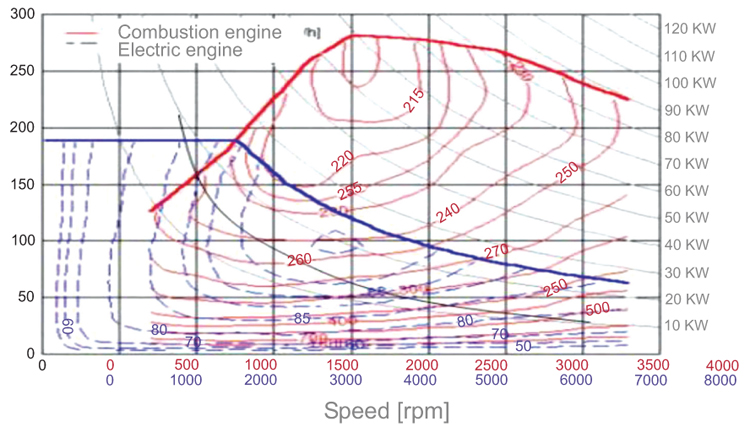 ).
).
 |
Fig. (1) Comparison b/n EV and IC Engine [30M. Felden, P. Bütterling, P. Jeck, L. Eckstein, and K. Hameyer, "Electric vehicle drive trains: From the specification sheet to the drive-train concept", Power Electronics and Motion Control Conference (EPE/PEMC), pp. S11-16. [http://dx.doi.org/10.1109/EPEPEMC.2010.5606531] ]. |
2. METHODS AND MATERIALS USED
2.1. Method and Experimental Setup Used
In order to get the target, showing the methods, how to develop the power transmission system for green and lightweight vehicle, is very crucial. The recent methodology used for Developing of power transmission system for green vehicles in comparison with conventional vehicle. These days the design and methodology of power transmission system can enhance both in terms of efficiency increment and weight reduction. The selection of new power transmission configuration (architecture) for green and lightweight vehicle is very accurate and feasible in terms of design evaluation over the conventional one. As depicted in Fig. (2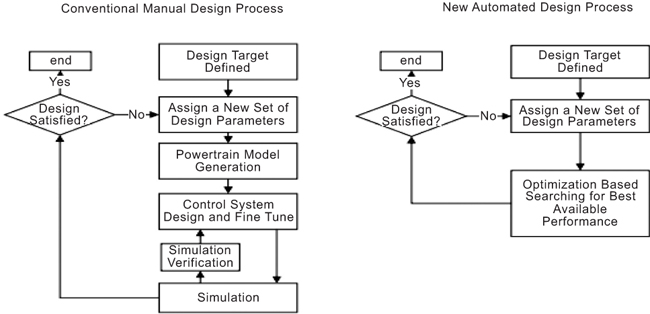 ) there is a clear comparison in design presses of the new automated with conventional.
) there is a clear comparison in design presses of the new automated with conventional.
 |
Fig. (2) Schematic of Powertrain Design process Conventional vs. Optimized Approach [31E. Schaltz, "Electrical vehicle design and modeling", Electric Vehicles-Modelling and Simulations, Ed. InTech. [http://dx.doi.org/10.5772/20271] ]. |
As can be seen in the schematics of Fig. (2 ), the transmission design target is defined, new design parameter should set (such as rated power, rated torque and speed) and design and control system was verified (shifting control) [32M. Karamuk, M.E. Çepni, and S. Otan, "Electric vehicle powertrain development: Conceptual design and implementation", International conference on automotive and vehicle technologies, AVTECH: Istanbul, Turkey, .], the simulation with different software i.e Matlab/simulink, AMEsim and Cruise [33P.D. Walker, S. Abdul Rahman, B. Zhu, and N. Zhang, "Modelling, simulations, and optimisation of electric vehicles for analysis of transmission ratio selection", Adv. Mech. Eng., vol. 5, p. 340435.
), the transmission design target is defined, new design parameter should set (such as rated power, rated torque and speed) and design and control system was verified (shifting control) [32M. Karamuk, M.E. Çepni, and S. Otan, "Electric vehicle powertrain development: Conceptual design and implementation", International conference on automotive and vehicle technologies, AVTECH: Istanbul, Turkey, .], the simulation with different software i.e Matlab/simulink, AMEsim and Cruise [33P.D. Walker, S. Abdul Rahman, B. Zhu, and N. Zhang, "Modelling, simulations, and optimisation of electric vehicles for analysis of transmission ratio selection", Adv. Mech. Eng., vol. 5, p. 340435.
[http://dx.doi.org/10.1155/2013/340435] ], finally the simulation result should be verified with experiment such as vehicle demonstrator, power train test ring as shown Fig. (3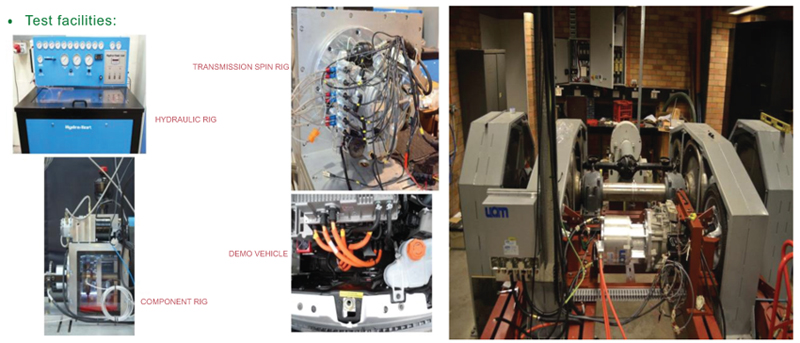 ) below.
) below.
 |
Fig. (3) Experimental Facilities for Transmission System [34B. Zhu, N. Zhang, P. Walker, W. Zhan, X. Zhou, and J. Ruan, "Two-speed DCT electric powertrain shifting control and rig testing", Adv. Mech. Eng., vol. 5, p. 323917. [http://dx.doi.org/10.1155/2013/323917] ]. |
Zhu, B., et al. [34B. Zhu, N. Zhang, P. Walker, W. Zhan, X. Zhou, and J. Ruan, "Two-speed DCT electric powertrain shifting control and rig testing", Adv. Mech. Eng., vol. 5, p. 323917.
[http://dx.doi.org/10.1155/2013/323917] ] discussed about the power train lab of test rig power transmission system components, hydraulic rigs, demo vehicle and driving cycle to test the shifting control and other parameters of .
Design of a new electric vehicle method provides more flexibility to optimize vehicle performance parameters and subsystems like weight, range, drivability, NVH (noise-vibration-harshness), regenerative brake, dedicated
Control algorithms in vehicle control unit etc are shown in Fig. (4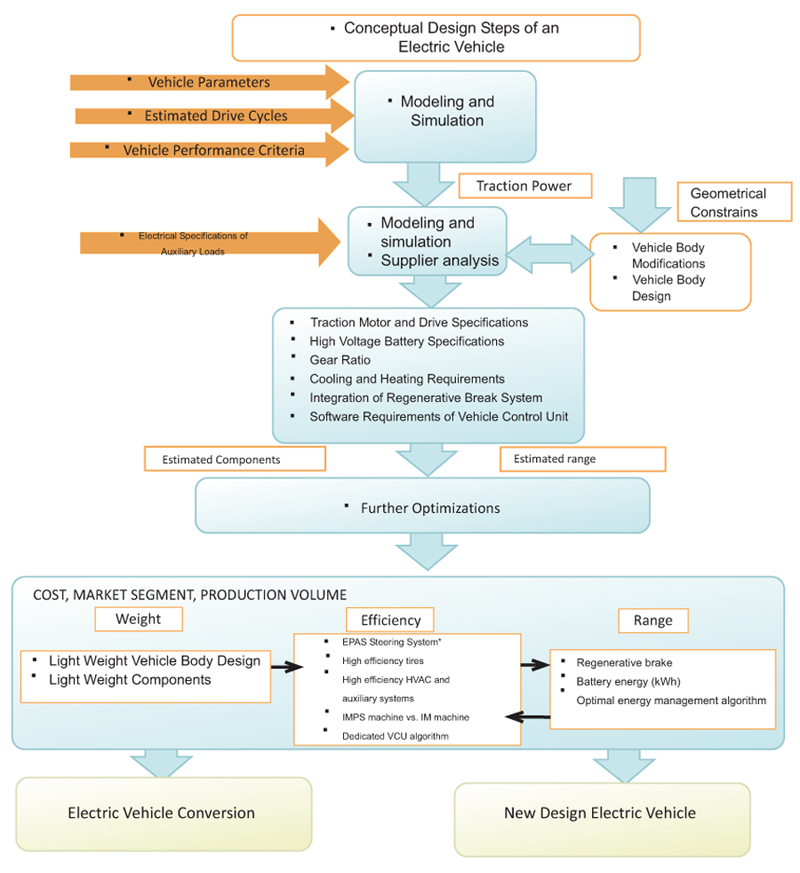 ) below.
) below.
Research paper of [11J.J. Oh, S.B. Choi, and J. Kim, "Driveline modeling and estimation of individual clutch torque during gear shifts for dual clutch transmission", Mechatronics, vol. 24, pp. 449-463.
[http://dx.doi.org/10.1016/j.mechatronics.2014.04.005] , 35Y. Liu, D. Qin, H. Jiang, and Y. Zhang, "Shift control strategy and experimental validation for dry dual clutch transmissions", Mech. Mach. Theory, vol. 75, pp. 41-53.
[http://dx.doi.org/10.1016/j.mechmachtheory.2014.01.013] , 38P. Prabhakar, M. Parameshwaran, and S. A. Kumar, Weight reduction of planetary gearbox pedestal using finite element analysis. Available from: http://www.msruas.ac.in/pdf_files/sastechJournals/Sept2013/2_Prabhakar.pdf], discuss about numerical and experimental investigation of drag torque in a two-speed dual clutch transmission testing performed using a green vehicle powertrain with a two-speed DCT uses a methodology of Measured input and output parameters like speed and torque and oil temperature of DCT case and test rig operated at stable conditions (gear, speed, motor torque, and oil temp) for at least two minutes. Both experiment and simulation were performed accordingly.
2.2. Material Used for Green vehicle Transmission
The type of materials used has a significant effect on fuel consumption and weight of vehicles as a result many researchers agree that in every 10% minimization in vehicle weight can reduce fuel consumption by about 5-7% so designer and manufacturers spent more time on searching for materials that have lightweight and can withstand the required load [37I. Stephan, Intelligent lightweight design by forged transmission components. Available from: http://www.massiverleichtbau.de/fileadmin/info/informationen_aus_der_branche/Intelligent_lightweight_design_Hirschvogel_Veroeffentlichung.pdf, 38P. Prabhakar, M. Parameshwaran, and S. A. Kumar, Weight reduction of planetary gearbox pedestal using finite element analysis. Available from: http://www.msruas.ac.in/pdf_files/sastechJournals/Sept2013/2_Prabhakar.pdf]. Power transmission system components comprise the heaviest system on the vehicle, therefore, weight reduction is more feasible in terms of fuel consumption [39N.R. Council, Cost, Effectiveness, and Deployment of Fuel Economy Technologies for Light-Duty Vehicles., National Academies Press, .].
Searching potential materials for power transmission components like gear, shaft, bearing and transmission casing are an essential scenario as material matters the life of transmission components in particular and the vehicle at large. With an anticipated vehicle life of between 10 and 20 years, the material property can increase the life by avoiding any deterioration in mechanical properties while extensive research has been undertaken into aluminum and ultra-high strength steels [40J. Kim, K. Cho, and S.B. Choi, "Gear shift control of dual clutch transmissions with a torque rate limitation trajectory", American Control Conference (ACC), pp. 3338-3343.].
To date due to environmental issues researchers are giving focus in composite materials due to good mechanical property. Vehicle power transmission components are manufactured from metal matrix composites (MMCs) that use filaments, whiskers or particles of high strength materials to enhance the properties of the base matrix in critical areas. A more ambitious solution is possible in the medium term, using polymer matrix composites (PMCs) [38P. Prabhakar, M. Parameshwaran, and S. A. Kumar, Weight reduction of planetary gearbox pedestal using finite element analysis. Available from: http://www.msruas.ac.in/pdf_files/sastechJournals/Sept2013/2_Prabhakar.pdf].
 |
Fig. (4) Design Steps of an Electric Vehicle [32M. Karamuk, M.E. Çepni, and S. Otan, "Electric vehicle powertrain development: Conceptual design and implementation", International conference on automotive and vehicle technologies, AVTECH: Istanbul, Turkey, .]. |
The needs for high output, long life, and minimizing the weight of automobiles drive train and machinery are constantly increasing, necessitating further increases in loads to gear and drive system parts like shafts [41S. Matsumura, and N. Hamasaka, High Strength and Compactness of Gears by WHSP (Double Hard Shot Peening) Technology. Available from: https://home.komatsu/en/company/tech-innovation/report/pdf/158-03_E.pdf]. To meet this demand, further enhancement of the strengths of the individual parts of the vehicle like gears, shafts are required. In response to these demands, a variety of attempts have been made in two aspects such as new material development and process improvement.
The paper of [42I.H. Naunheimer, "Specification and Design of Shafts", Automotive Transmissions, ed: SpringerBerlin, Heidelberg, pp. 278-299.
[http://dx.doi.org/10.1007/978-3-642-16214-5_8] ] discusses the importance of energy and environmental concerns, in designing transmission components, it is important to pay attention to all aspects of a product including its manufacturing, operation, and maintenance in addition [42I.H. Naunheimer, "Specification and Design of Shafts", Automotive Transmissions, ed: SpringerBerlin, Heidelberg, pp. 278-299.
[http://dx.doi.org/10.1007/978-3-642-16214-5_8] ] also address that gears are a basic component of vehicle power transmissions. The manufacturing process of transmission gears is, therefore, a central task in the gear production. There is, on one hand, the possibility of giving the tooth contour its final geometry already in the soft state, in which case the gear only need to be hardened. The advantage of this method is the short process chain and results to lower costs. On the other hand, inaccuracies caused by distortion due to hardening are usually unacceptable, in which case hard machining must follow the hardening process.
Li et al. [43X. Li, M. Sosa, and U. Olofsson, "A pin-on-disc study of the tribology characteristics of sintered versus standard steel gear materials", Wear, vol. 340, pp. 31-40.
[http://dx.doi.org/10.1016/j.wear.2015.01.032] ] used pin-on-disc experiments to show that regular steel (16MnCr5) disks on powder metallurgy (PM) material pins, and PM material disks on PM material pins, had lower friction coefficients than regular steel disks on regular steel pins. On the basis of these results [44X. Li, and U. Olofsson, "FZG gear efficiency and pin-on-disc frictional study of sintered and wrought steel gear materials", Tribol. Lett., vol. 60, p. 9.
[http://dx.doi.org/10.1007/s11249-015-0582-6] ], investigated the gear mesh torque loss of regular steel gears and PM material gears. They found that running a standard material gear against a PM gear can improve the efficiency of transmission gears. Li et al. also investigated that the gear mesh torque loss of regular steel and PM material ground gears but the efficiency of super finished PM gear are unknown. The current technology shows little potential of gear weight reduction due to the trade-off between mass optimization and the manufacturing process.
Sardinha T G et al. [10J. Savoy, "Light-Weight Assembled Gears: A green design solution for passenger and commercial vehicles", Gear Technology, pp. 64-71.] Discusses different materials can be used for the inner and outer part of the gear. In other words, more substantial and more expensive steel is restricted to the outer part which must possess the highest mechanical strength, while the other parts can be manufactured with lower grade steels or alternative steel materials. The process used for hardening the surface is using heat treatment process which can be applied locally.
Research paper of [18Y-S. Yoon, S. Kim, and K-S. Kim, "Conceptual design of economic hybrid vehicle system using clutchless geared smart transmission", Int. J. Automot. Technol., vol. 14, pp. 779-784.
[http://dx.doi.org/10.1007/s12239-013-0086-z] ] Investigates by applying the technology of Low Pressure Carburizing (LPC) and High Pressure Gas Quenching (HPGQ), the tooth root bending strength can be significantly enhanced, compared to traditional heat treatment with atmospheric carburizing and oil quenching. The hardenability of case hardening steels such as 5130 H, 5120H, 20MnCr5, 27MnCr5, 18CrNiMo7-6 etc. has been stepwise increased in recent years. An important factor for fatigue resistance is the grain size after heat treatment. Therefore, grain size control is a key goal when developing new modifications of steel grades. Volker Heuer et al added that after enhancing grain size control, it was possible to increase the carburizing temperatures over the past years from 930°C to 980°C (1700°F to 1800°F) which resulted in shorter heat treatment cycles and achieve significant cost savings. With the introduction of new micro alloyed steels for grain size stability, carburizing temperatures can now be even further increased to temperatures of up to 1050°C (1920°F), leading to even more economic process cycles. By adding microelements such as Niobium or Titanium in the parts per million (ppm) range, nitride and carbon nitride-precipitates are formed. These precipitates effectively limit the grain-growth during the heat treatment process.
L. ZHANG et al. [45L. Zhang, B.G. Thomas, X. Wang, and K. Cai, "Evaluation and control of steel cleanliness-review", Steelmaking Conference Proceedings, pp. 431-452.] Discuss about demand for cleaner steels increases every year. In addition to lowering non-metallic oxide inclusions and controlling their morphology, composition and size distribution, clean steel requires lowering other residual impurity elements such as sulfur, phosphorus, hydrogen, nitrogen and even carbon, and trace elements such as As, Sn, Sb, Se, Cu, Pb, and Bi.
Bao et.al [46S. Bao, X. Wang, L. Zhang, S. Yang, and K. D. Peaslee, Improving steel cleanliness through slag refining, .] discuss In order to achieve composition well-controlled alloy steel for the current studies, high purity electrolytic iron was melted in a vacuum induction furnace, then high purity electrolytic manganese, single crystal silicon chromium-iron, molybdenum-iron and granular carbon powders were added into the crucible to adjust the composition of the steel, and to deoxidize the steel. Aluminum metal was then added to the melt to adjust the content of the dissolved aluminum in the steel. The initially dissolved aluminum in the steel ranged from 14ppm to 503ppm. The steel composition is similar to that of 42CrMo steel.
Thapliyal, Vivek [47V. Thapliyal, Inclusion engineering in Mn-Si de-oxidized steel for thin-strip casting., Missouri University of Science and Technology, .] discussed about the benefits of removing inclusions for outweigh the negatives. Large inclusions can be easily removed from the steel by utilizing good industrial practices. Following are the common techniques utilized to remove inclusions: Degassing treatment, Floatation, Inclusion Entrapment by Slag, Inclusion Entrapment by Refractory, Gas Bubbling and Electromagnetic Stirring
Qi Zhang, et al [48Q. Zhang, J. Zhang, C. Wu, Z. Xu, and S. Lyu, "The evaluation of contact fatigue strength for 20MnCr5 carburized gear", Int. J. Precis. Eng. Manuf., vol. 15, pp. 117-121.
[http://dx.doi.org/10.1007/s12541-013-0313-6] ] evaluates contact fatigue strength of the gear; for that motor speed of 1440 RPM was maintained at 1000 Nm. Load clutch is carried by front shaft which is used to apply the load. The flanges of the load clutch are twisted relative to each other and bolted together for applying load and torque was applied by weights and load lever.
3. RESULTS AND DISCUSSION
The results and discussion of this review papers will discuss in this chapter. Their results are different as they apply different methods and for different applications. Bernd Matthes [20B. Matthes, Dual clutch transmissions-lessons learned and future potential, .
[http://dx.doi.org/10.4271/2005-01-1021] ] discuss the fuel efficiency of various power transmission types in terms of fuel saving and comfort rating. As it depicted in Fig. (5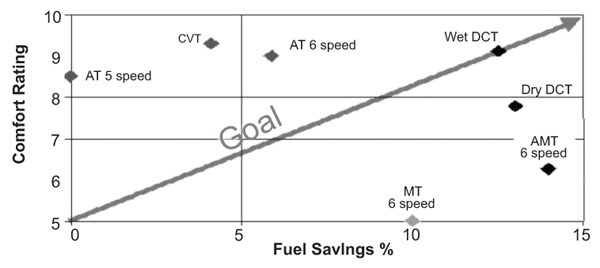 ) below, the best fuel economy transmission is AMT which is even better than manual transmission. In addition to the AMT, the wet DCTs and dry DCTs have the highest efficiency as well as good comfort. However, if passengers’ comfort and driver’s preference are considered, AMT is not the first option for conventional vehicles which only contain one power source. Based on the combined factors, the DCTs are the best choice for conventional vehicles.
) below, the best fuel economy transmission is AMT which is even better than manual transmission. In addition to the AMT, the wet DCTs and dry DCTs have the highest efficiency as well as good comfort. However, if passengers’ comfort and driver’s preference are considered, AMT is not the first option for conventional vehicles which only contain one power source. Based on the combined factors, the DCTs are the best choice for conventional vehicles.
 |
Fig. (5) Transmission Comfort and Fuel Efficiency Comparison [20B. Matthes, Dual clutch transmissions-lessons learned and future potential, . [http://dx.doi.org/10.4271/2005-01-1021] ]. |
Fig. (6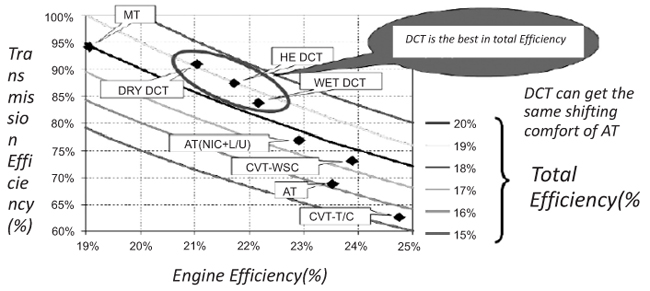 ) also shows the efficiency analysis and a comparison between different transmissions types. From the graph as clearly shown that the highest efficiency belongs to DCTs, especially the dry clutch DCT as stated in [49B. Zhu, Research of two speed DCT electric power-train and control system, Doctoral dissertation, .].
) also shows the efficiency analysis and a comparison between different transmissions types. From the graph as clearly shown that the highest efficiency belongs to DCTs, especially the dry clutch DCT as stated in [49B. Zhu, Research of two speed DCT electric power-train and control system, Doctoral dissertation, .].
 |
Fig. (6) Transmission Efficiency under NEDC Drive Cycle [49B. Zhu, Research of two speed DCT electric power-train and control system, Doctoral dissertation, .]. |
Council, N.R [39N.R. Council, Cost, Effectiveness, and Deployment of Fuel Economy Technologies for Light-Duty Vehicles., National Academies Press, .]. investigated that the difference in power losses between wet and dry clutch DCTs are shown in Fig. (7a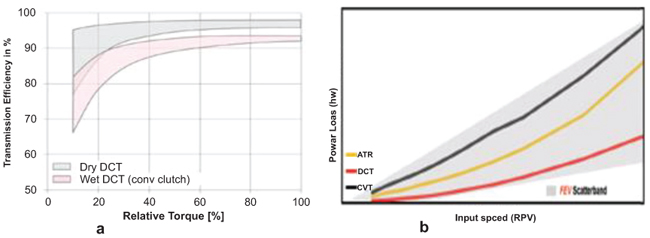 ) as a result dry DCT has more efficiency than wet DCT. DCTs typically have the lowest losses comparing to other transmission types such as Automatic Transmission (ATs), Dual Clutch Transmission (DCT) and Continues Variable Transmission (CVT) as shown clearly in Fig. (7b
) as a result dry DCT has more efficiency than wet DCT. DCTs typically have the lowest losses comparing to other transmission types such as Automatic Transmission (ATs), Dual Clutch Transmission (DCT) and Continues Variable Transmission (CVT) as shown clearly in Fig. (7b ).
).
 |
Fig. (7) Comparison of a) Wet and Dry DCT Efficiency b) power losses of d/t transmission [39N.R. Council, Cost, Effectiveness, and Deployment of Fuel Economy Technologies for Light-Duty Vehicles., National Academies Press, .]. |
Hong, S., et al [36S. Hong, H. Son, S. Lee, J. Park, K. Kim, and H. Kim, "Shift control of a dry-type two-speed dual-clutch transmission for an electric vehicle", Proceedings of the Institution of Mechanical Engineers, Part D: J. Automob. Eng., vol. 230, pp. 308-321.
[http://dx.doi.org/10.1177/0954407015585686] ] discuss about the efficiency versus angular speed graph of both experimental and analytical results shows that DCT, average efficiency of about 95% for both gears although second gear was slightly higher compared to first gear as depicted in the Fig. (8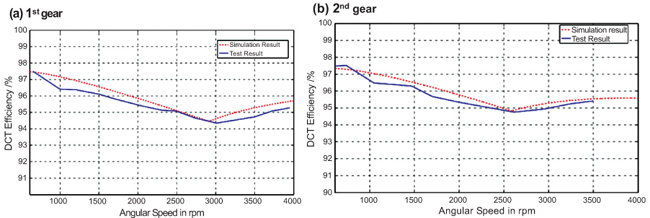 ). The results shown in Fig. (8
). The results shown in Fig. (8 ) are the first gear and second gear efficiency both test result and analytical results prediction at constant input torque and constant input speed respectively as depicted in figure below.
) are the first gear and second gear efficiency both test result and analytical results prediction at constant input torque and constant input speed respectively as depicted in figure below.
 |
Fig. (8) DCT Efficiency b/n Simulation and Test results with Input Torque 60 N•m [36S. Hong, H. Son, S. Lee, J. Park, K. Kim, and H. Kim, "Shift control of a dry-type two-speed dual-clutch transmission for an electric vehicle", Proceedings of the Institution of Mechanical Engineers, Part D: J. Automob. Eng., vol. 230, pp. 308-321. [http://dx.doi.org/10.1177/0954407015585686] ]. |
In Fig. (9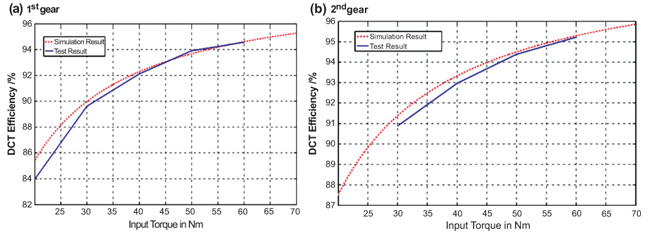 ), the graph depicts efficiency versus angular speed with parameters like constant input speed and variable input torque from the power source of electric motor. The input torque for the first gear and second gear is variable while the input speed is constant for both gears. The variable input torque between the two gears is due to variable gear ration i.e. second gear ratio (G2 = 5.36) and first one (G1 = 8.45).
), the graph depicts efficiency versus angular speed with parameters like constant input speed and variable input torque from the power source of electric motor. The input torque for the first gear and second gear is variable while the input speed is constant for both gears. The variable input torque between the two gears is due to variable gear ration i.e. second gear ratio (G2 = 5.36) and first one (G1 = 8.45).
 |
Fig. (9) Comparison of DCT Efficiency b/n Simulation and Test Results with Input speed 3000rpm [36S. Hong, H. Son, S. Lee, J. Park, K. Kim, and H. Kim, "Shift control of a dry-type two-speed dual-clutch transmission for an electric vehicle", Proceedings of the Institution of Mechanical Engineers, Part D: J. Automob. Eng., vol. 230, pp. 308-321. [http://dx.doi.org/10.1177/0954407015585686] ]. |
Sorniotti, A., et al. [50A. Sorniotti, T. Holdstock, G.L. Pilone, F. Viotto, S. Bertolotto, and M. Everitt, "Analysis and simulation of the gearshift methodology for a novel two-speed transmission system for electric powertrains with a central motor", Proceedings of the Institution of Mechanical Engineers, Part D: J. Automob. Eng., vol. 226, pp. 915-929.
[http://dx.doi.org/10.1177/0954407011431415] ] discuss the selection of electric drive motor rated speed and maximum speed depends upon the torque-speed characteristics curve of electric motor. As can be seen in Fig. (10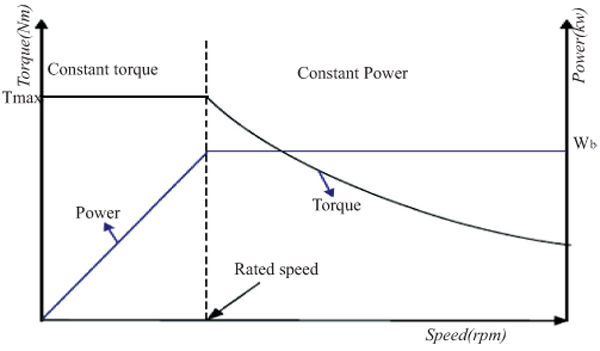 ), during stating the torque gets higher and the motor speed lower, when the motor speed reaches rated speed the torque decreases as shown clearly in Fig. (10
), during stating the torque gets higher and the motor speed lower, when the motor speed reaches rated speed the torque decreases as shown clearly in Fig. (10 ).
).
Research paper of Sorniotti, A., et al. [50A. Sorniotti, T. Holdstock, G.L. Pilone, F. Viotto, S. Bertolotto, and M. Everitt, "Analysis and simulation of the gearshift methodology for a novel two-speed transmission system for electric powertrains with a central motor", Proceedings of the Institution of Mechanical Engineers, Part D: J. Automob. Eng., vol. 226, pp. 915-929.
[http://dx.doi.org/10.1177/0954407011431415] ] also discussed about a different type of power transmission system of green vehicle. The comparison study has been done with green vehicles equipped with 2-speed and single speed transmission. As results shown in Fig. (12a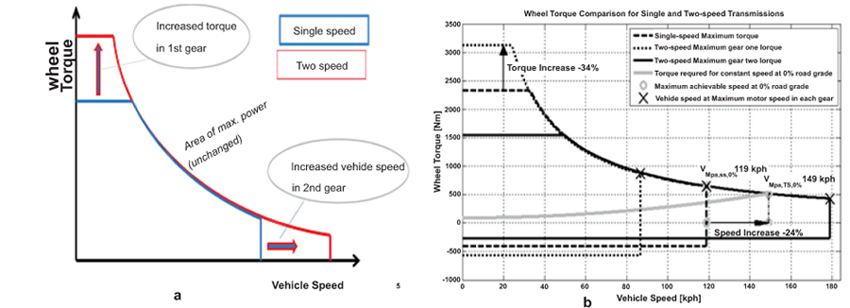 & b
& b ), 2-speed transmission have higher torque in the first gear compared to single speed transmission. In addition, the electric motor speed increases in second gear compared to single speed transmission. As results shown in Fig. (12b
), 2-speed transmission have higher torque in the first gear compared to single speed transmission. In addition, the electric motor speed increases in second gear compared to single speed transmission. As results shown in Fig. (12b ) 2-speed transmission bring an increase of 34% in wheel torque compared to single speed transmission, in the same manner the motor speed increases 24% over single-speed transmission, and consequently in a higher efficiency region of the motor drive as shown in Fig. (11
) 2-speed transmission bring an increase of 34% in wheel torque compared to single speed transmission, in the same manner the motor speed increases 24% over single-speed transmission, and consequently in a higher efficiency region of the motor drive as shown in Fig. (11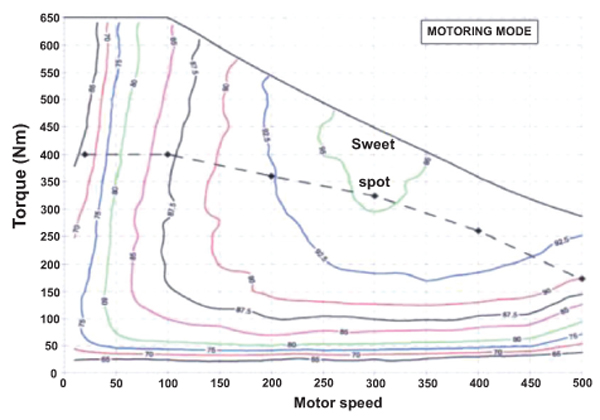 ) of the efficiency map of electric motor. The advantages of 2- speed transmission can Stall torque requirement can reduce this leading to downsizing of electric machine and the efficiency can be optimized, which leads to increased driving range and Top speed can be increased as shown in Fig. (13
) of the efficiency map of electric motor. The advantages of 2- speed transmission can Stall torque requirement can reduce this leading to downsizing of electric machine and the efficiency can be optimized, which leads to increased driving range and Top speed can be increased as shown in Fig. (13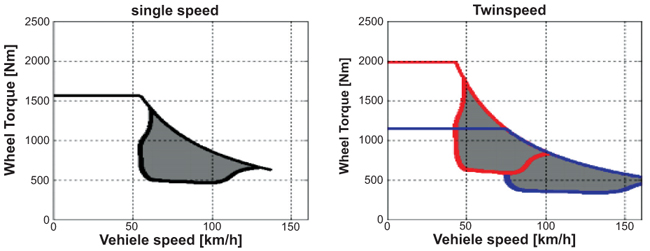 ) below [53A. Sorniotti, G.L. Pilone, F. Viotto, S. Bertolotto, M. Everitt, and R. Barnes, "A novel seamless 2-speed transmission system for electric vehicles: Principles and simulation results", SAE Int. J. Engines, vol. 4, pp. 2671-2685.
) below [53A. Sorniotti, G.L. Pilone, F. Viotto, S. Bertolotto, M. Everitt, and R. Barnes, "A novel seamless 2-speed transmission system for electric vehicles: Principles and simulation results", SAE Int. J. Engines, vol. 4, pp. 2671-2685.
[http://dx.doi.org/10.4271/2011-37-0022] , 54K. Hata, T. Imura, and Y. Hori, Dynamic wireless power transfer system for electric vehicle to simplify ground facilities-power control based on vehicle-side information EVS28, .].
 |
Fig. (10) Drive Motor Torque Characteristics [51M. Zhou, L. Zhao, Y. Zhang, Z. Gao, and R. Pei, "Pure electric vehicle power-train parameters matching based on vehicle performance", Int. J Contr. Automat., vol. 8, pp. 53-62. [http://dx.doi.org/10.14257/ijca.2015.8.9.06] ]. |
 |
Fig. (11) Efficiency Map of Electric Engine [52F. Viotto, A novel seamless 2-speed Transmission system for electric Vehicles, Principles and simulation results, .]. |
 |
Fig. (12) Advantage of 2 Speed Transmissions over Single Speed Transmission [54K. Hata, T. Imura, and Y. Hori, Dynamic wireless power transfer system for electric vehicle to simplify ground facilities-power control based on vehicle-side information EVS28, .]. |
Sorniotti, A., et al. [50A. Sorniotti, T. Holdstock, G.L. Pilone, F. Viotto, S. Bertolotto, and M. Everitt, "Analysis and simulation of the gearshift methodology for a novel two-speed transmission system for electric powertrains with a central motor", Proceedings of the Institution of Mechanical Engineers, Part D: J. Automob. Eng., vol. 226, pp. 915-929.
[http://dx.doi.org/10.1177/0954407011431415] ] also discussed the comparison between single speed and 2-speed transmission based on the Optimum efficiency of electric machines typically at medium or high speed and at high load. However, in reality, the most frequent use in real driving is at various speeds and at relatively low load. Two speeds transmission can increase the effective area of high efficiency over single speed transmission as shown in Fig. (14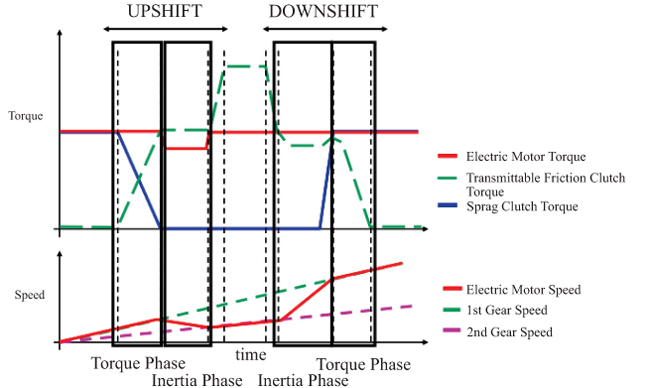 ) [54K. Hata, T. Imura, and Y. Hori, Dynamic wireless power transfer system for electric vehicle to simplify ground facilities-power control based on vehicle-side information EVS28, .].
) [54K. Hata, T. Imura, and Y. Hori, Dynamic wireless power transfer system for electric vehicle to simplify ground facilities-power control based on vehicle-side information EVS28, .].
 |
Fig. (13) Comparison of Working is b/n Single Speed & 2- Speed Transmission [50A. Sorniotti, T. Holdstock, G.L. Pilone, F. Viotto, S. Bertolotto, and M. Everitt, "Analysis and simulation of the gearshift methodology for a novel two-speed transmission system for electric powertrains with a central motor", Proceedings of the Institution of Mechanical Engineers, Part D: J. Automob. Eng., vol. 226, pp. 915-929. [http://dx.doi.org/10.1177/0954407011431415] ]. |
 |
Fig. (14) Upshift and Downshift of 2 Speed Transmissions [36S. Hong, H. Son, S. Lee, J. Park, K. Kim, and H. Kim, "Shift control of a dry-type two-speed dual-clutch transmission for an electric vehicle", Proceedings of the Institution of Mechanical Engineers, Part D: J. Automob. Eng., vol. 230, pp. 308-321. [http://dx.doi.org/10.1177/0954407015585686] ]. |
Felden, M., et al. [30M. Felden, P. Bütterling, P. Jeck, L. Eckstein, and K. Hameyer, "Electric vehicle drive trains: From the specification sheet to the drive-train concept", Power Electronics and Motion Control Conference (EPE/PEMC), pp. S11-16.
[http://dx.doi.org/10.1109/EPEPEMC.2010.5606531] ] discussed the chart in Table 1 below, which illustrates the advantages and disadvantages of the various electric vehicle transmission concepts. As long as one can dispense with the purely cylindrical dimensions of the electric engine, the spur gearbox offers the simpler solution for the coaxial layout. Based on these considerations, a 2-speed gearbox is only possible with a spur gearbox. The spur gearbox is also recommended for parallel coaxial layouts.
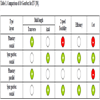
Comparison of d/t Gearbox for EV [30M. Felden, P. Bütterling, P. Jeck, L. Eckstein, and K. Hameyer, "Electric vehicle drive trains: From the specification sheet to the drive-train concept", Power Electronics and Motion Control Conference (EPE/PEMC), pp. S11-16.
[http://dx.doi.org/10.1109/EPEPEMC.2010.5606531] ].
Kulkarni, M., T. Shim, and Y. Zhang [13M. Kulkarni, T. Shim, and Y. Zhang, "Shift dynamics and control of dual-clutch transmissions", Mech. Mach. Theory, vol. 42, pp. 168-182.
[http://dx.doi.org/10.1016/j.mechmachtheory.2006.03.002] ], discussed gearshifts in a dual-clutch transmission (DCT) are realized by torque transfer from one clutch to another without traction interruption due to the controlled slippage of the clutches. A shift control algorithm to improve the shift quality was proposed for an electric vehicle with a dry-type two-speed dual-clutch transmission. To analyze the shift characteristics of the target electric vehicle, dynamic models for the two-speed dual-clutch transmission and the drivetrain were developed. Based on the dynamic models, dynamic equations for the transient shift states were derived, and a shift performance simulator was constructed. From analysis of the transient shift state, it was found that the fluctuations in the driveshaft torque, which cause the shift quality to deteriorate, occurred as a result of the inertia torque. Based on the analytical results, a control algorithm was proposed using traction motor torque control as well as shift actuator stroke control. For traction motor control, a compensation torque was applied during the inertia phase. In that phase, actuator stroke control was performed by considering the torque margin and the kissing point during the torque phase instead of the existing map-based control. To evaluate the performance of the proposed control algorithm, a test bench for the target electric vehicle was developed. From the experimental results, it was found that the variations in the driveshaft torque and in the jerk were reduced by the proposed control algorithm, which thereby provides an improved shift quality as S. Hong et.al [36S. Hong, H. Son, S. Lee, J. Park, K. Kim, and H. Kim, "Shift control of a dry-type two-speed dual-clutch transmission for an electric vehicle", Proceedings of the Institution of Mechanical Engineers, Part D: J. Automob. Eng., vol. 230, pp. 308-321.
[http://dx.doi.org/10.1177/0954407015585686] ] stated.
F.Viotto, Oerlikon Drive Systems [53A. Sorniotti, G.L. Pilone, F. Viotto, S. Bertolotto, M. Everitt, and R. Barnes, "A novel seamless 2-speed transmission system for electric vehicles: Principles and simulation results", SAE Int. J. Engines, vol. 4, pp. 2671-2685.
[http://dx.doi.org/10.4271/2011-37-0022] ], discussed about novel two-speed transmission system as depicted in Figs. (14 and 15
and 15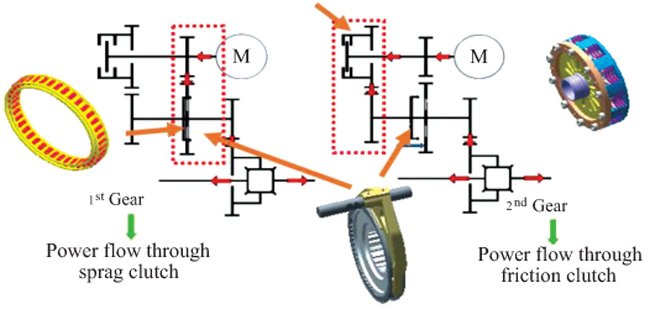 ). The component parts like sprag clutch which is located in the second shaft while friction clutch is found in the primary shaft of dual shaft transmission. The principle operation of transmission works as follows, the input torque is transmitted by the sprag clutch whilst in first gear, and by the friction clutch whilst in second gear. The friction clutch is applied to transfer torque from the sprag clutch during an upshift, and released to allow the sprag clutch to engage to accomplish a downshift. Generally, the 2 speed DCT transmission is advantageous in terms of gearshift comfort and fuel efficiency.
). The component parts like sprag clutch which is located in the second shaft while friction clutch is found in the primary shaft of dual shaft transmission. The principle operation of transmission works as follows, the input torque is transmitted by the sprag clutch whilst in first gear, and by the friction clutch whilst in second gear. The friction clutch is applied to transfer torque from the sprag clutch during an upshift, and released to allow the sprag clutch to engage to accomplish a downshift. Generally, the 2 speed DCT transmission is advantageous in terms of gearshift comfort and fuel efficiency.
 |
Fig. (15) Schematic Transmission Operation in first gear (left) and second gear (right) [53A. Sorniotti, G.L. Pilone, F. Viotto, S. Bertolotto, M. Everitt, and R. Barnes, "A novel seamless 2-speed transmission system for electric vehicles: Principles and simulation results", SAE Int. J. Engines, vol. 4, pp. 2671-2685. [http://dx.doi.org/10.4271/2011-37-0022] ]. |
CONCLUSION
The continuing demand for fuel economy improvements is forcing the automotive industry to reduce weight. The current trend towards lightweight design in automotive industry, also the weight of the transmissions has to be reduced. An optimization of the production process is necessary as well as the reduction of input material. Furthermore, reducing the weight and loss of transmission components can increase fuel efficiency and enhance greenness of vehicle.
To minimize the drag torque the shifting time should minimize. Therefore, decreasing the gearshift time can enhance vehicle comfort this can be done with the help of actuators.
CONSENT FOR PUBLICATION
Not applicable.
CONFLICT OF INTEREST
The authors declare no conflict of interest, financial or otherwise.
ACKNOWLEDGEMENTS
Declared none.
REFERENCES
| [1] | M. Ehsani, Y. Gao, and A. Emadi, Modern electric, hybrid electric, and fuel cell vehicles: fundamentals, theory, and design, CRC press, . |
| [2] | M.F.H. Vehicles, Associated press article published in Macomb Daily, . |
| [3] | A. Ebron, and J. Ranta, Education and outreach for future fuels–tapping into cool and addressing resistance the advanced electric drive vehicle education program a program of west virginia university.. |
| [4] | J. Shin, J. Kim, J. Choi, and S. Oh, "Design of 2-speed transmission for electric commercial vehicle", Int. J. Automot. Technol., vol. 15, p. 145. [http://dx.doi.org/10.1007/s12239-014-0016-8] |
| [5] | Y. Itakura, Osumi Y., and LI G., "One Motor Type Electric Vehicle Drive System", Technical review, . |
| [6] | N. REGULATION, "510/2011 of the European parliament and o the council", May, 11th, . |
| [7] | D.F. Brasil, Resolution no. 315, dated October 29, 2002. Provides for the new stage of the Vehicle Emission Control Program-PROCONVE, vol. 20, Daily Official of the Union, . |
| [8] | I. Steinberg, R. Nasdal, and A. Kurtzke, "GETRAG 6HDT451:“Mild-Hybrid Including Wet-Running Dual-Clutch", 35th VDI Congress, Vehicle Transmissions, . |
| [9] | H. Naunheimer, B. Bertsche, J. Ryborz, W. Novak, H. Naunheimer, and B. Bertsche, "Matching Engine and Transmission", Automot. Transmission., pp. 115-139. |
| [10] | J. Savoy, "Light-Weight Assembled Gears: A green design solution for passenger and commercial vehicles", Gear Technology, pp. 64-71. |
| [11] | J.J. Oh, S.B. Choi, and J. Kim, "Driveline modeling and estimation of individual clutch torque during gear shifts for dual clutch transmission", Mechatronics, vol. 24, pp. 449-463. [http://dx.doi.org/10.1016/j.mechatronics.2014.04.005] |
| [12] | P.D. Walker, A.R. Salisa, B. Zhu, and N. Zhang, "Modelling and optimisation of pure electric vehicle powertrains: A comparison of single and two speed transmissions", Int. J. Vehicle Perform., vol. 2, pp. 85-102. [http://dx.doi.org/10.1504/IJVP.2015.074125] |
| [13] | M. Kulkarni, T. Shim, and Y. Zhang, "Shift dynamics and control of dual-clutch transmissions", Mech. Mach. Theory, vol. 42, pp. 168-182. [http://dx.doi.org/10.1016/j.mechmachtheory.2006.03.002] |
| [14] | F. Bottiglione, S. De Pinto, G. Mantriota, and A. Sorniotti, "Energy consumption of a battery electric vehicle with infinitely variable transmission", Energies, vol. 7, pp. 8317-8337. [http://dx.doi.org/10.3390/en7128317] |
| [15] | B. Szimandl, and H. Németh, "Dynamic hybrid model of an electro-pneumatic clutch system", Mechatronics, vol. 23, pp. 21-36. [http://dx.doi.org/10.1016/j.mechatronics.2012.10.006] |
| [16] | X. Song, C-S. Wu, and Z. Sun, "Design, modeling, and control of a novel automotive transmission clutch actuation system", IEEE/ASME Trans. Mechatron., vol. 17, pp. 582-587. [http://dx.doi.org/10.1109/TMECH.2011.2176499] |
| [17] | K. Zhao, Y. Liu, X. Huang, R. Yang, and J. Wei, "Uninterrupted shift transmission and its shift characteristics", IEEE/ASME Trans. Mechatron., vol. 19, pp. 374-383. [http://dx.doi.org/10.1109/TMECH.2012.2235183] |
| [18] | Y-S. Yoon, S. Kim, and K-S. Kim, "Conceptual design of economic hybrid vehicle system using clutchless geared smart transmission", Int. J. Automot. Technol., vol. 14, pp. 779-784. [http://dx.doi.org/10.1007/s12239-013-0086-z] |
| [19] | S. Kim, C. Song, K-S. Kim, and Y-S. Yoon, "Analysis of the shifting behavior of a novel clutchless geared smart transmission", Int. J. Automot. Technol., vol. 15, pp. 125-134. [http://dx.doi.org/10.1007/s12239-014-0014-x] |
| [20] | B. Matthes, Dual clutch transmissions-lessons learned and future potential, . [http://dx.doi.org/10.4271/2005-01-1021] |
| [21] | L. De Novellis, A. Sorniotti, and P. Gruber, "Design and comparison of the handling performance of different electric vehicle layouts", Proceedings of the Institution of Mechanical Engineers, Part D: J. Automob. Eng., vol. 228, pp. 218-232. [http://dx.doi.org/10.1177/0954407013506569] |
| [22] | A. Sorniotti, S. Subramanyan, A. Turner, C. Cavallino, F. Viotto, and S. Bertolotto, "Selection of the optimal gearbox layout for an electric vehicle", SAE Int. J. Engines, vol. 4, pp. 1267-1280. [http://dx.doi.org/10.4271/2011-01-0946] |
| [23] | F. Di Nicola, A. Sorniotti, T. Holdstock, F. Viotto, and S. Bertolotto, "Optimization of a multiple-speed transmission for downsizing the motor of a fully electric vehicle", SAE Int. J. Alternative Powertrains, vol. 1, pp. 134-143. [http://dx.doi.org/10.4271/2012-01-0630] |
| [24] | T. Hofman, and C. Dai, "Energy efficiency analysis and comparison of transmission technologies for an electric vehicle", Vehicle Power and Propulsion Conference (VPPC), pp. 1-6. [http://dx.doi.org/10.1109/VPPC.2010.5729082] |
| [25] | Z. Zhang, C. Zuo, W. Hao, Y. Zuo, X. Zhao, and M. Zhang, "Three-speed transmission system for purely electric vehicles", Int. J. Automot. Technol., vol. 14, pp. 773-778. [http://dx.doi.org/10.1007/s12239-013-0085-0] |
| [26] | C. Xu, J. Niu, and F. Pei, "Design and simulation of the power-train system for an electric vehicle", Artificial Intelligence, Management Science and Electronic Commerce (AIMSEC), 2011 2nd International Conference on, pp. 3868-3871. |
| [27] | C. Xiusheng, S. Yongdao, G. Qiang, and L. Xi, "Shift control for dry dual clutch transmission of pure electric vehicle", Transportation, Mechanical, and Electrical Engineering (TMEE), 2011 International Conference on, pp. 854-857. [http://dx.doi.org/10.1109/TMEE.2011.6199336] |
| [28] | P.D. Walker, N. Zhang, and R. Tamba, "Control of gear shifts in dual clutch transmission powertrains", Mech. Syst. Signal Process., vol. 25, pp. 1923-1936. [http://dx.doi.org/10.1016/j.ymssp.2010.08.018] |
| [29] | C. C. Ming, and S. J. Cin, "Performance analysis of EV powertrain system with/without transmission", World Electric Vehicle J., vol. 4, p. 000629. |
| [30] | M. Felden, P. Bütterling, P. Jeck, L. Eckstein, and K. Hameyer, "Electric vehicle drive trains: From the specification sheet to the drive-train concept", Power Electronics and Motion Control Conference (EPE/PEMC), pp. S11-16. [http://dx.doi.org/10.1109/EPEPEMC.2010.5606531] |
| [31] | E. Schaltz, "Electrical vehicle design and modeling", Electric Vehicles-Modelling and Simulations, Ed. InTech. [http://dx.doi.org/10.5772/20271] |
| [32] | M. Karamuk, M.E. Çepni, and S. Otan, "Electric vehicle powertrain development: Conceptual design and implementation", International conference on automotive and vehicle technologies, AVTECH: Istanbul, Turkey, . |
| [33] | P.D. Walker, S. Abdul Rahman, B. Zhu, and N. Zhang, "Modelling, simulations, and optimisation of electric vehicles for analysis of transmission ratio selection", Adv. Mech. Eng., vol. 5, p. 340435. [http://dx.doi.org/10.1155/2013/340435] |
| [34] | B. Zhu, N. Zhang, P. Walker, W. Zhan, X. Zhou, and J. Ruan, "Two-speed DCT electric powertrain shifting control and rig testing", Adv. Mech. Eng., vol. 5, p. 323917. [http://dx.doi.org/10.1155/2013/323917] |
| [35] | Y. Liu, D. Qin, H. Jiang, and Y. Zhang, "Shift control strategy and experimental validation for dry dual clutch transmissions", Mech. Mach. Theory, vol. 75, pp. 41-53. [http://dx.doi.org/10.1016/j.mechmachtheory.2014.01.013] |
| [36] | S. Hong, H. Son, S. Lee, J. Park, K. Kim, and H. Kim, "Shift control of a dry-type two-speed dual-clutch transmission for an electric vehicle", Proceedings of the Institution of Mechanical Engineers, Part D: J. Automob. Eng., vol. 230, pp. 308-321. [http://dx.doi.org/10.1177/0954407015585686] |
| [37] | I. Stephan, Intelligent lightweight design by forged transmission components. Available from: http://www.massiverleichtbau.de/fileadmin/info/informationen_aus_der_branche/Intelligent_lightweight_design_Hirschvogel_Veroeffentlichung.pdf |
| [38] | P. Prabhakar, M. Parameshwaran, and S. A. Kumar, Weight reduction of planetary gearbox pedestal using finite element analysis. Available from: http://www.msruas.ac.in/pdf_files/sastechJournals/Sept2013/2_Prabhakar.pdf |
| [39] | N.R. Council, Cost, Effectiveness, and Deployment of Fuel Economy Technologies for Light-Duty Vehicles., National Academies Press, . |
| [40] | J. Kim, K. Cho, and S.B. Choi, "Gear shift control of dual clutch transmissions with a torque rate limitation trajectory", American Control Conference (ACC), pp. 3338-3343. |
| [41] | S. Matsumura, and N. Hamasaka, High Strength and Compactness of Gears by WHSP (Double Hard Shot Peening) Technology. Available from: https://home.komatsu/en/company/tech-innovation/report/pdf/158-03_E.pdf |
| [42] | I.H. Naunheimer, "Specification and Design of Shafts", Automotive Transmissions, ed: SpringerBerlin, Heidelberg, pp. 278-299. [http://dx.doi.org/10.1007/978-3-642-16214-5_8] |
| [43] | X. Li, M. Sosa, and U. Olofsson, "A pin-on-disc study of the tribology characteristics of sintered versus standard steel gear materials", Wear, vol. 340, pp. 31-40. [http://dx.doi.org/10.1016/j.wear.2015.01.032] |
| [44] | X. Li, and U. Olofsson, "FZG gear efficiency and pin-on-disc frictional study of sintered and wrought steel gear materials", Tribol. Lett., vol. 60, p. 9. [http://dx.doi.org/10.1007/s11249-015-0582-6] |
| [45] | L. Zhang, B.G. Thomas, X. Wang, and K. Cai, "Evaluation and control of steel cleanliness-review", Steelmaking Conference Proceedings, pp. 431-452. |
| [46] | S. Bao, X. Wang, L. Zhang, S. Yang, and K. D. Peaslee, Improving steel cleanliness through slag refining, . |
| [47] | V. Thapliyal, Inclusion engineering in Mn-Si de-oxidized steel for thin-strip casting., Missouri University of Science and Technology, . |
| [48] | Q. Zhang, J. Zhang, C. Wu, Z. Xu, and S. Lyu, "The evaluation of contact fatigue strength for 20MnCr5 carburized gear", Int. J. Precis. Eng. Manuf., vol. 15, pp. 117-121. [http://dx.doi.org/10.1007/s12541-013-0313-6] |
| [49] | B. Zhu, Research of two speed DCT electric power-train and control system, Doctoral dissertation, . |
| [50] | A. Sorniotti, T. Holdstock, G.L. Pilone, F. Viotto, S. Bertolotto, and M. Everitt, "Analysis and simulation of the gearshift methodology for a novel two-speed transmission system for electric powertrains with a central motor", Proceedings of the Institution of Mechanical Engineers, Part D: J. Automob. Eng., vol. 226, pp. 915-929. [http://dx.doi.org/10.1177/0954407011431415] |
| [51] | M. Zhou, L. Zhao, Y. Zhang, Z. Gao, and R. Pei, "Pure electric vehicle power-train parameters matching based on vehicle performance", Int. J Contr. Automat., vol. 8, pp. 53-62. [http://dx.doi.org/10.14257/ijca.2015.8.9.06] |
| [52] | F. Viotto, A novel seamless 2-speed Transmission system for electric Vehicles, Principles and simulation results, . |
| [53] | A. Sorniotti, G.L. Pilone, F. Viotto, S. Bertolotto, M. Everitt, and R. Barnes, "A novel seamless 2-speed transmission system for electric vehicles: Principles and simulation results", SAE Int. J. Engines, vol. 4, pp. 2671-2685. [http://dx.doi.org/10.4271/2011-37-0022] |
| [54] | K. Hata, T. Imura, and Y. Hori, Dynamic wireless power transfer system for electric vehicle to simplify ground facilities-power control based on vehicle-side information EVS28, . |



